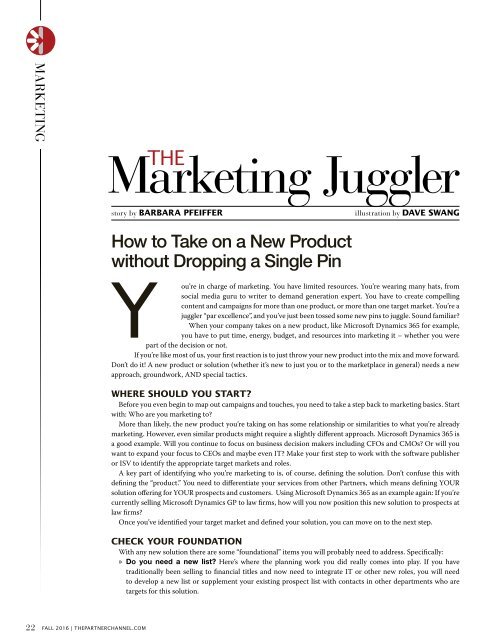The Partner Channel Magazine Fall 2016
This issue centers around the announcement of Microsoft Dynamics 365 and what it means for Partners in the channel. Dig in to explore more Microsoft-focused hot topics.
This issue centers around the announcement of Microsoft Dynamics 365 and what it means for Partners in the channel. Dig in to explore more Microsoft-focused hot topics.
You also want an ePaper? Increase the reach of your titles
YUMPU automatically turns print PDFs into web optimized ePapers that Google loves.
MARKETING<br />
Marketing<br />
THE<br />
Juggler<br />
story by BARBARA PFEIFFER<br />
illustration by DAVE SWANG<br />
How to Take on a New Product<br />
without Dropping a Single Pin<br />
You’re in charge of marketing. You have limited resources. You’re wearing many hats, from<br />
social media guru to writer to demand generation expert. You have to create compelling<br />
content and campaigns for more than one product, or more than one target market. You’re a<br />
juggler “par excellence”, and you’ve just been tossed some new pins to juggle. Sound familiar?<br />
When your company takes on a new product, like Microsoft Dynamics 365 for example,<br />
you have to put time, energy, budget, and resources into marketing it – whether you were<br />
part of the decision or not.<br />
If you’re like most of us, your first reaction is to just throw your new product into the mix and move forward.<br />
Don’t do it! A new product or solution (whether it’s new to just you or to the marketplace in general) needs a new<br />
approach, groundwork, AND special tactics.<br />
WHERE SHOULD YOU START?<br />
Before you even begin to map out campaigns and touches, you need to take a step back to marketing basics. Start<br />
with: Who are you marketing to?<br />
More than likely, the new product you’re taking on has some relationship or similarities to what you’re already<br />
marketing. However, even similar products might require a slightly different approach. Microsoft Dynamics 365 is<br />
a good example. Will you continue to focus on business decision makers including CFOs and CMOs? Or will you<br />
want to expand your focus to CEOs and maybe even IT? Make your first step to work with the software publisher<br />
or ISV to identify the appropriate target markets and roles.<br />
A key part of identifying who you’re marketing to is, of course, defining the solution. Don’t confuse this with<br />
defining the “product.” You need to differentiate your services from other <strong>Partner</strong>s, which means defining YOUR<br />
solution offering for YOUR prospects and customers. Using Microsoft Dynamics 365 as an example again: If you’re<br />
currently selling Microsoft Dynamics GP to law firms, how will you now position this new solution to prospects at<br />
law firms?<br />
Once you’ve identified your target market and defined your solution, you can move on to the next step.<br />
CHECK YOUR FOUNDATION<br />
With any new solution there are some “foundational” items you will probably need to address. Specifically:<br />
» Do you need a new list? Here’s where the planning work you did really comes into play. If you have<br />
traditionally been selling to financial titles and now need to integrate IT or other new roles, you will need<br />
to develop a new list or supplement your existing prospect list with contacts in other departments who are<br />
targets for this solution.<br />
22 FALL <strong>2016</strong> | THEPARTNERCHANNEL.COM














